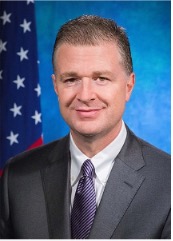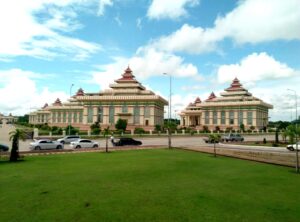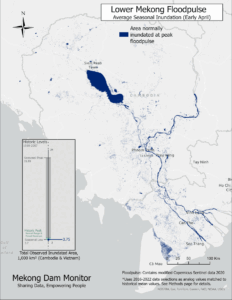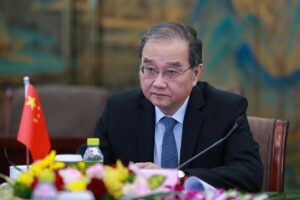These remarks were delivered by Assistant Secretary of State Daniel J. Kritenbrink on October 18, 2021, at the Opening Plenary of the Mekong – U.S. Partnership Track 1.5 Policy Dialogue on Infrastructure and Energy.
The Mekong-U.S. Partnership Track 1.5 Policy Dialogues (Partnership Policy Dialogues) are a series of six multi-day conferences that will take place from 2021 – 2023 to explore solutions to key policy and sustainability challenges facing the Lower Mekong. This second Partnership Policy Dialogue explored policy challenges and best practices from the US, Mekong countries, and development partner countries related to the renewable energy transition, regional power trade, cross-border economic corridor development, ESGs, and climate adaptation, among other opportunities. The Partnership Policy Dialogues are generously supported by a grant from the U.S. Department of State and implemented by the Stimson Center and the International Union for the Conservation of Nature (IUCN).
Remarks
Good morning and good evening, everyone. It is an honor to speak to so many distinguished guests, YSEALI participants, innovators, leaders, and policy makers from across the region. It is a region I am passionate about, having recently returned from serving as U.S. ambassador to Vietnam.
Thank you to the Stimson Center and to the International Union of Nature Conservancy for putting together today’s events and to Mr. Brunner for emceeing this morning’s panel.
Today, and across the next few days, the Stimson Center and I-U-C-N have compiled an ambitious agenda that we know will lead to insightful discussions.
You’ll be hearing from expert panelists from the Mekong sub-region and across the United States government.
Mekong-U.S. Partnership Overview
I’d like to start by introducing the Mekong-U.S. Partnership, the signature U.S. initiative in mainland Southeast Asia and the one that is convening us all today.
This Partnership has achieved a great deal in its first year, a testament to the commitment of the United States to the Mekong sub-region. Spanning two U.S. presidential administrations, the M-U-S-P represents, like the Lower Mekong Initiative before it, a sustained commitment to the people of this great region.
In August, Secretary Blinken and his Mekong counterparts committed to a three-year Mekong-U.S. Partnership Plan of Action. That plan of action, and the broader Partnership within which it sites, includes more than 50 programs and millions of dollars in U.S. foreign assistance. These U.S. programs are just a subset of the many projects our likeminded partners – Australia, the Republic of Korea, the EU, Japan, India, and others – are undertaking in the region. The Secretary convened these partners when he chaired the Friends of the Mekong ministerial and welcomed the Mekong River Commission as the group’s newest member.
Secretary Blinken also recently unveiled four flagship programs, including:
- The Mekong Safeguards program, which helps countries develop standards for quality infrastructure;
- The Mekong Water Data Initiative, which enables open access to data; and
- Pathfinder Health, a tool sharing and funding source for research into emerging threats in health security.
The fourth flagship program – the Mekong-U.S. Partnership Track 1.5 Policy Dialogues – is what brings us all together for this Today, we open the second of what will be a total of seven dialogues. This dialogue will focus on energy and infrastructure.
In fact, it was citizens of the Mekong who participated in that first Track 1.5 dialogue this past March who recommended that we hold a dialogue on energy and infrastructure.
You’ll notice this as a central component of our approach under the Mekong-U.S. Partnership: we are dedicated to solutions that respect the will of the Mekong sub-region and do so in a way that promotes transparency, good governance, and economic opportunities for its people.
Energy
As all of you know, all five Mekong sub-region countries are managing rising and shifting electricity demand driven by population growth, urbanization, industrialization, and digitalization.
The United States is working with Mekong partner governments to help address these demands.
Since 2019, the Japan-U.S. Mekong Power Partnership, known as JUMPP, has provided technical support to increase renewable energy, cross-border power trade, and energy market reform. Next month, Japan and the United States will meet with Thailand, Vietnam, Cambodia, and Lao PDR to identify new areas of collaboration. We are also working through a U.S. government-supported battery storage pilot project in Vietnam, and electric vehicles projects in Thailand and Lao PDR. These pilots underscore our emphasis on renewables development and work to catalyze new commercial opportunities in the region.
Infrastructure Planning
We are doing similar good work with our Mekong partners on infrastructure planning and sustainable natural resource management.
For example, the Sustainable Infrastructure Partnership is a multi-partner platform established by the Friends of the Mekong that helps Mekong stakeholders assess the cumulative impact of infrastructure projects by incorporating socio-economic data in regional planning. Through the Sustainable Infrastructure Partnership and the Mekong Water Data Initiative, Mekong countries can now share critical water-related data necessary for science-based decision-making.
Mekong Safeguards, as I mentioned earlier, is the M-U-S-P’s flagship Economic Connectivity program, managed by USAID. It provides policy makers, government regulators, financiers, and contractors with information and tools to apply environmental, social, and governance standards for infrastructure development.
Programs like Mekong Safeguards and others support locally developed solutions, improve transparency in infrastructure decision-making, and accelerate the role of the private sector as a driver of developmnt.
We also aim to improve standards for infrastructure projects through the Blue Dot Network, an effort we are undertaking with our OECD partners to spark a global “race to the top” for sustainable, quality infrastructure.
The Mekong-U.S. Partnership is also in the process of expanding our project on east-west connectivity with the U.S. Department of Transportation and local Mekong authorities. This project aims to identify the most viable routes to increase cross-border trade and transportation in the Mekong sub-region.
We’re also working with our Mekong partners through the U.S.-ASEAN Smart Cities Partnership to make our cities more sustainable. For example, Phnom Penh, Phuket, and Ho Chi Minh City have been paired up with water and transportation authorities and U.S. companies in Boston, Milwaukee, and San Francisco to share best practices and experiences.
In many of the presentations over the next few days, you’ll hear more about our efforts to partner with the U.S. private sector, including from my colleagues at the U.S. International Development Finance Corporation.
In conclusion
This is only a snapshot of the what the U.S. government is doing. The Mekong-U.S. Partnership is bringing us all together to share what the United States is doing on energy and infrastructure, but, more importantly, to hear what you are doing. And to hear how we can support you as we work together as partners in these efforts.
The various sessions of this week’s dialogue are designed to give you the space and time to generate solutions and to advise each other and all of us on how we can best act as good partners.
I look forward to reading the Track 1.5 Policy Dialogue follow-on report that comes out of your sessions this week. I know my State Department and interagency colleagues are eager to incorporate these recommendations into tangible actions.
I thank you again and I look forward to seeing what the participants of the second Track 1.5 Policy Dialogue on Infrastructure and Energy can achieve together.

Daniel J. Kritenbrink became Assistant Secretary of State for East Asian and Pacific Affairs on September 24, 2021. A career member of the Senior Foreign Service, Class of Career Minister, Kritenbrink has been an American diplomat since 1994.
Assistant Secretary Kritenbrink previously served as U.S. Ambassador to the Socialist Republic of Vietnam (2017-2021), Senior Director for Asian Affairs at the National Security Council (2015-2017), and Deputy Chief of Mission at the U.S. Embassy in Beijing (2013-2015). He also completed multiple other overseas tours in Beijing, Tokyo, Sapporo, and Kuwait City. His other Washington assignments have included the Director of the Office of Chinese and Mongolian Affairs at the Department of State and the Staff Assistant to the Assistant Secretary of State for Near Eastern Affairs.
A Nebraska native, Assistant Secretary Kritenbrink earned a master’s degree at the University of Virginia, and a bachelor’s degree at the University of Nebraska-Kearney. He speaks Chinese and Japanese.



